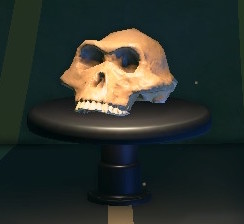Australopith
From Nookipedia, the Animal Crossing wiki
The australopith is a standalone fossil in Animal Crossing: New Horizons.
Donating to the museum[edit]
In New Horizons[edit]
When the player donates to Blathers or selects "Tell me about this!" in New Horizons, he will provide the following information about the fossil:
"The australopith, thought to be one of the links between humans and apes, emerged 4,000,000 years ago. They lived long ago, even before the ancestors of the modern humans, so there are profound differences... Even so, it seems to me that you can see the beginnings of greatness here!"
The Australopith can be found in the last room of the fossil exhibit in the museum.
As an item[edit]
In New Horizons[edit]
| Australopith | |
|---|---|
| Interactable | No |
| Sell price | |
| Colors | Beige
Brown
|
| Size | |
Real-world information[edit]
Australopithecus is one of the most well-known fossils in the lineage that leads to modern humans. It is one of the first human ancestors known to have walked on two legs.
More information on this topic is available at Wikipedia.
Trivia[edit]
- At around 2 AM, the Australopith's eyes will start flickering blue.[1]
Names in other languages[edit]
| アウストラロピテクス Ausutoraropitekusu |
Australopithecus | |
| 오스트랄로피테쿠스 Oseuteurallopitekuseu |
Australopithecus | |
| 南方古猿 (iQue) Nánfāng gǔ yuán |
Australopithecus | |
| Австралопитек Avstalopitek |
Australopithecus | |
| Australopithecus | - | |
| Australopithecus | - | |
| Australopiteco | - | |
| Australopithèque | - | |
| Australopiteco | - | |
| This article is a stub. You can help Nookipedia by expanding it. |
| Fossils | ||||||||||||||||||||||||
|---|---|---|---|---|---|---|---|---|---|---|---|---|---|---|---|---|---|---|---|---|---|---|---|---|
| ||||||||||||||||||||||||
- ↑ u/icfloor (March 27, 2020). "Australopith eyes glowing at 2:49 am". Reddit. Retrieved May 28, 2023.

